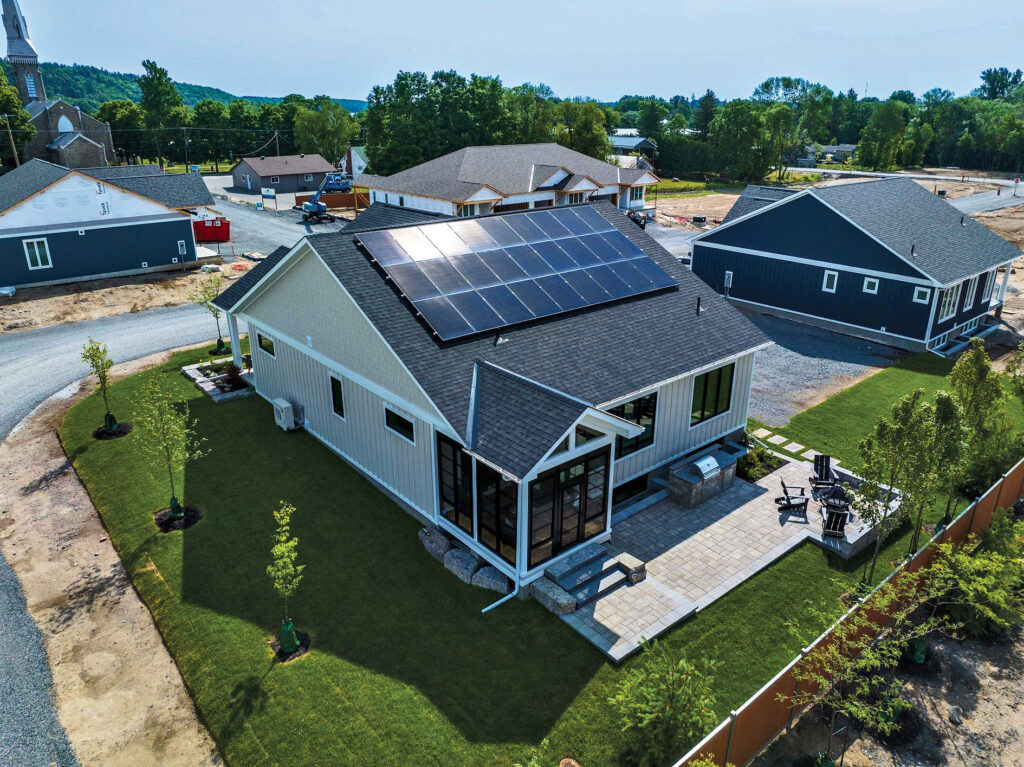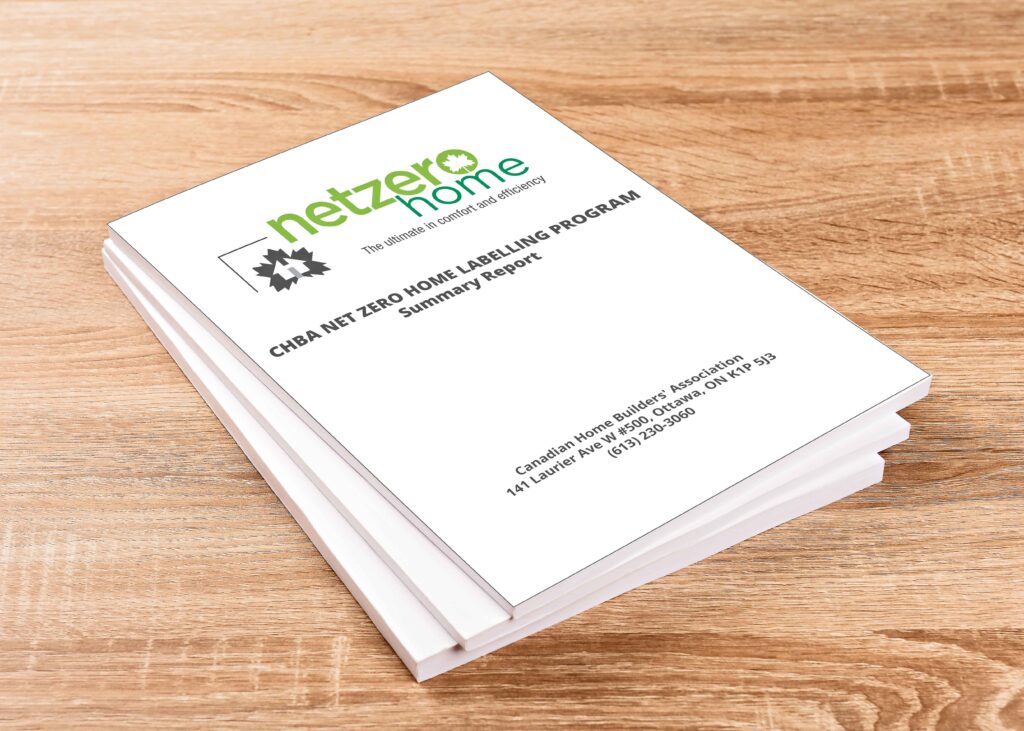By Natasha Rombough, Director of Marketing and Communications, CHBA
Operational emissions. Embodied emissions. Resilience. Concepts that years ago were only discussed by the staunchest environmentalists are now frequently making their way into conversations within the residential construction industry. And, perhaps more critically to builders and renovators who will have to adapt, those concepts are making their way into Canada’s future building codes – with a timeline for the national model codes right now as early as 2027.
The landscape is changing rapidly, making it challenging for many who work within it to keep up. While the Association is working hard to bring common sense to the code development process, builders and renovators must stay informed about code changes that do take place and make sure the trade contractors they work with know how to apply them. Builders are also looking to manufacturers to innovate to meet new requirements with products that are easy to use and not cost prohibitive. Municipalities and their inspectors have to understand the changes and be consistent about how they’re applied and inspected. It’s a lot.
To conquer these challenging topics and help builders navigate new and emerging science, CHBA is engaging at various levels: 1) by continuing the important work on proposed codes and standards making sure proposals are buildable and cost effective, 2) by enhancing the CHBA Net Zero Home Labelling Program with new voluntary guidelines on emissions and resilience (helping industry leaders lead while providing valuable builder insight into the regulatory process regarding opportunities and challenges) and 3) by working with the insurance industry, which is extremely concerned about catastrophic losses.

The evolution of CHBA’s Net Zero Home Labelling Program
While many recent code changes have stemmed from a focus on energy efficiency, Canadian builders have a long history of striving to produce the best homes possible. Members of CHBA who were passionate about innovating to voluntarily deliver higher performance homes were the impetus behind CHBA’s Net Zero Council, which was formed in 2014. Its purpose was (and still is) to support members voluntarily pursuing Net Zero Energy performance. By sharing advancements, new construction methods and lessons learned, members engaged in the Council learn from each other, and gain a market advantage in their businesses.
One of the Council’s key initiatives was developing the CHBA Net Zero Home Labelling Program, which was piloted in 2015. Since then, more than 2,000 homes have been labelled, including new attached and detached single-family homes and multi-unit residential buildings (MURBs) and renovations. The program provides the industry and consumers with clearly defined and rigorous two-tiered technical requirements that recognize Net Zero and Net Zero Ready Homes, and the builders and renovators that provide them.

Today, CHBA still emphasizes in its federal government advocacy that building to Net Zero performance standards should remain voluntary because technology and the industry at large still has a long way to go in being able to build high-performance homes without adversely impacting housing affordability. However, energy efficiency requirements are getting more stringent in the codes – expected to reach net zero ready performance levels in the national model code by 2030 – and the Net Zero training through CHBA helps builders and renovators understand how to meet all levels of energy.
As technologies and high-performance home construction techniques evolve, the program has expanded in response. After a two-year Natural Resources Canada (NRCan) funded project which included reviewing the technical requirements and a pilot with six home renovations, renovations became part of the program in 2021. With support from NRCan, CHBA is delivering another multi-year initiative “towards net zero renovations,” working with select municipalities who have programs supporting deep energy retrofits and working to give direction to their constituents on viable pathways to upgrade their existing home to Net Zero or Net Zero Ready. The project is due to wrap up in 2026.
In addition to achieving exceptional energy performance, builders and renovators participating in CHBA’s Net Zero Home Labelling Program are also able to promote that their homes are comfortable, with healthy indoor environments. To further that aim, an Indoor Air Quality (IAQ) Picklist was added to the requirements in 2023. Several of the mandatory requirements on the picklist were already requirements of the Net Zero Home Labelling Program, and the remaining items, which builders can pick from as long as their options add up to the minimum requirements, help enhance IAQ beyond what is provided solely from addressing energy performance.
The Program is also adapting to address industry challenges for more housing types. Recognizing that some building types, such as multi-unit residential buildings (MURBs), have unique circumstances due to their restricted roof space available for solar panels, an alternative compliance path was introduced to the Net Zero Home Labelling Program in 2024.

Preparing the industry for tiered codes
In July this year, CHBA announced a new project to help prepare the industry for future building codes. The project, Enabling Tiered Codes – Implementation and Market Preparedness, is funded by NRCan under the Codes Acceleration Fund (CAF), which is part of the federal government’s Green Buildings Strategy to accelerate innovation in making Canada’s buildings more affordable, efficient, comfortable and resilient.
As explained in CHBA’s press release, the objective of the project is to support efforts to help enable the residential construction industry to cost-effectively build to forthcoming high-performance building codes, including the highest feasible energy performance tiers of the national model energy codes or other high-performance building codes, such as net-zero emissions codes, by building industry capacity.

CHBA staff attend hundreds of codes and standards meetings each year, analyzing thousands of pages of information concerning proposed code changes, getting feedback from members on the real-world application consequences, and bringing that information back to Codes Canada. We know that tiered energy codes are coming, though as always it will be up to the provinces as to when they get adopted.
This project will build industry’s capacity to comply with tiered codes’ requirements, which are being implemented in many provinces right now. Through a set of new training courses, the project will educate builders on the initial requirements of the tiered codes in the 2020 NBC and on the coming changes to the energy tiers in the 2025 national building codes, incenting more builders and energy advisors to take advantage of existing building science and net zero training, and developing additional programming and tools. Through the project, CHBA will expand the scope of its Net Zero Home Labelling Program by providing builders and energy advisors with starting points to guide their project to Net Zero Ready, using Builder Option Packages (BOPs) to make the process more straightforward.
Emissions and resilience
Until recently, the focus has been on energy efficiency: Reducing energy consumption by improving the building envelope and mechanicals, and generating the remaining energy needed with renewable energy. As the industry is still grappling with rapid changes on that front, just around the corner may be the need to reduce both operational and embodied greenhouse gas (GHG) emissions (also known as carbon emissions). Operational GHG (opGHG) emissions are generated from the operation of the home’s mechanical systems, which is significantly impacted by the fuel used to generate the energy available from the grid. Embodied GHG (emGHG) emissions are generated during the production and transportation of the materials until they arrive at a construction site. This encompasses everything from the logging of framing lumber to the manufacturing of all products installed in the home.
Another giant challenge is how to build any home to be more climate resilient. The increase in extreme weather events has the media, government, and homeowners talking about how resilient our homes are in the face of high winds, hail, wildfires and flooding, and extended high heat events, including heat domes.

CHBA continues to actively advise that more research is needed to ensure that homes can be built “carbon-effective” and climate resilient and that they remain affordable for future homebuyers. Through the new Enabling Tiered Codes project, CHBA has established the Emissions and Resilience Working Group, a committee of experts to inform the development of operational and embodied carbon emissions programming, as well as resilience best practices to protect homes and the people living in them against extreme weather events due to climate change, all the while looking at affordability. The results of the project will also help to inform the building code process, as it looks at buildability, costs and other hurdles that need to be overcome for successful implementation if these subjects are to become code requirements.
CHBA is also collaborating with the Institute for Catastrophic Loss Reduction (ICLR) on a Resilient Homes Task Force (RHTF) project. The Task Force is working to create evidence-based voluntary solutions for more resilient new homes, renovations and homeowner maintenance. These solutions will help inform the residential construction industry and Canadians about options and home and property insurances to protect property and residents from increasing weather extremes and catastrophic loss. The Resilient Homes Task Force will conduct pilot field trials with builders using homes in various locations across Canada, testing four specific natural hazard contexts: Basement flooding, wildfire, hail and high wind. The learnings from those outcomes will be used to create resources and guides for the residential construction industry, insurers and homeowners, outlining voluntary risk reduction initiatives for Canadian homes.

Next steps
CHBA members from across the country involved in CHBA’s national committees and councils, including the Net Zero Council and Technical Research Committee, as well as the many others who volunteer their time on various task forces and initiatives, are working with CHBA staff to lead the way to optimally building and renovating high-performance homes through innovative solutions while ensuring housing affordability is minimally impacted.
Building to all these new requirements and keeping homes affordable is an extremely difficult task. All the upcoming changes to building codes will have further adverse impacts on housing affordability, and so it is crucial to make sure that any recommendation to improve emissions and resilience performance is first tested against affordability. Which is why it’s so important that members bring their expertise to the table to help inform the future of homebuilding and renovation in Canada – industry must do its best to lead the input into the code process.
If you’re interested in learning more about the work that CHBA and its members are doing about government advocacy on topics like housing supply and affordability, building codes, and more, subscribe to CHBA’s Industry Highlights, a media scan on housing issues and developments, with CHBA commentary. Login to your account and sign up here: chba.ca/highlights.








